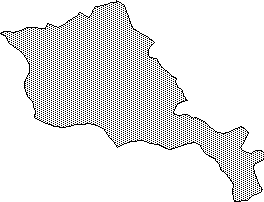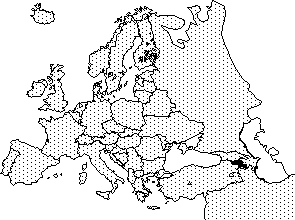[Front page] [Contents] [Previous] [Next] |
Management of Contaminated Sites and Land in Central and Eastern Europe
Armenia
Country Characterisation


Background
The land contamination issue is one of the main land management problems in Armenia. The problem is almost as serious as soil erosion or land degradation. However, the problem is not yet so serious as the problems with treatment and disposal of industrial and municipal wastes or depletion of biological resources.
The importance of the problem is now increasing, taking into account the different sources of land contamination.
Although the overall environmental pollution situation in Armenia has improved during the recent years, this is primarily related to the drop in industrial production due to the earthquake in 1988, the collapse the USSR, and the numerous socio-economic problems. Now the economy begins to recover and therefore pollution problems are very likely to become more evident again.
Total area |
Agricultural areas |
Wooded areas |
Nationally protected areas |
Other areas |
||||
km2 |
km2 |
% |
km2 |
% |
km2 |
% |
km2 |
% |
29800 |
14000 |
47 |
3341 |
11 |
3055 |
10 |
||
| Figure on total area from UN/ECE, 1998. | ||||||||
Population |
Population density |
Annual pop. growth |
Life expectancy at birth Male Female |
|||||
1000 |
per km2 |
% |
years |
years |
||||
| 3787 | 127 | 1,42 | 69 | 76 | ||||
| Figures from UN/ECE, 1998, and POPIN, 1999. | ||||||||
Legal and Administrative Basis
Definition of Contaminated Sites and Land
There is no specific definition for contaminated sites and land.
Legislation
For the ecologically safe and economically effective management of the environmental pollution the following laws and regulations have been adopted:
| Principles of Nature Protection Legislation (1991). | |
| Law on Environmental Impacts (1995). | |
| Law on Air Protection (1994). | |
| Water Code (1992). | |
| Land Code (1991). | |
| Governmental Decision No. 448 (1998). Introducing taxes and fees on air and water pollution and industrial disposals in landfills, as well as on the use of surface waters, groundwater and mineral water, and on discharges of industrial wastewater. Taxes and fees are to be paid by the operational industrial and transport companies, regardless of ownership. | |
| Governmental Decision No. 97 (08.12.1995). The order of adjustment of hazardous wastes import, export and transit over the territory of Armenia. The Decision regulates all the issues, concerning transboundary movement of hazardous wastes. This document is prepared on the base of the Basel Convention. The Parliament of Armenia have adopted the Basel Convention "On the control of transboundary movement of hazardous wastes and their disposal" on March 26, 1999. |
Implementation of Limit Values
Aiming at characterising contaminants levels in water, air and soil, the values of MPC (maximum permissible concentration) and RC (residual concentration) are implemented.
Responsible Public Authorities
Within the Ministry of Nature Protection, the Division of Land Protection and a recently organised Division of Hazardous Substances are responsible for the management of contaminated sites.
Registration
Staff at the Centre for Ecological and Neosphere Studies of the National Academy of Sciences has developed and implemented a method for the mapping of sites contaminated by heavy metals. This will contribute to the communication of results to the citizens.
Characterisation of Soil and Groundwater Contamination
Sources of Soil and Groundwater Contamination
The following types of contaminated sites and land are of major importance in Armenia:
| Industrial sites. In Armenia principal sources of industrial pollution are mining, metallurgical, chemical, and construction industry. The emissions from these contain a complex of heavy metals (arsenic, lead, cadmium, nickel etc.), fluorine and chlorine compounds (including dioxins), cyanic and nitrogen compounds, and other substances, that cause soil and groundwater contamination. | |
| Landfills. A principal factor of land contamination is industrial and household wastes. During the years 1985 – 1990 about 36,7 million tonne of industrial wastes were generated, and 20,0 thousand tonne of this was toxic waste. Now, it is difficult to estimate the current amount of industrial waste generation in the country. | |
| Contamination of agricultural land. The problems mentioned above for industrial sites also have an impact on agricultural land in areas near the sites. Furthermore, agricultural land, especially in the region of Ararat valley, is contaminated with pesticides and fertilisers. Though the use of the most harmful chlororganic pesticides (DDT, DDE and heptachlor) was prohibited in the 1970ties, investigation performed in 1995-96 revealed high residual concentrations of these pesticides in some soils. Besides, after the privatisation of the agricultural land in 1992 and the breakdown of the former centralised pesticide supply system the present use of pesticides can not be controlled. | |
| Mining sites. Today, there is no clear data on land contamination caused by mining activities. Deposits of mine tails, dumps and slag contain high concentrations of pollutants that might also spread to surrounding areas. | |
| Sites contaminated with lead. Due to the economic conditions, some people in Yerevan use plots of land that are contaminated with high concentrations of lead. The sources of this contamination are industrial emissions and use of leaded petrol. |
It is noted that there are no facilities for treatment or recovery of recyclable industrial and household waste. In addition, a significant part of the industrial waste is dumped in the landfills for municipal waste without any preceding treatment.
There are 45 urban and 429 rural landfills for municipal solid waste in Armenia, and the total landfill areas occupy about 1500 ha. The landfills have been constructed without special planning permission or environmental impact assessments. Usually landfills are not covered with soil. High concentrations of heavy metals have been found in landfills leading also to contamination of soil and groundwater.
Number of Registered Contaminated Sites / Contaminated Land Areas
There is no estimate on the number of contaminated sites.
Examples of likely contaminated sites are:
| A copper and molybdenum factory in Kadjaran. In some zones of the factory area, contamination of soil with copper and molybdenum is considerable high. | |
| A gold extracting plant in Ararat. It is estimated that an area of about 20 km2 surrounding the factory is contaminated by heavy metals. The concentration of arsenic exceeds the maximum permissible concentrations (MPC) several hundred times. | |
| Chemical plants in Vanadzor and Yerevan. |
Investigation Methods
Identification of Potentially Contaminated Sites and Areas
There are no sources of respective data.
Investigation of Contaminated Sites and Areas
To detect heavy metals contamination in soils, atomic-adsorptive and spectrographic methods are used and implemented into practice.
Facilities for Contaminated Soil
Handling and Treatment of Excavated Contaminated Soil
Up till now, no facilities exist for contaminated soil, though Armenian researchers develop some clean-up technologies for contaminated soils.
Measures Used by Remediation of Soil and Groundwater Contamination
Staff at the Centre for Ecological and Neospheric Investigations at the National Academy of Science is working on development of a technology for cleaning sites contaminated with heavy metals, cyanic and nitrogen compounds, and pesticides. The use of the technology will provide for the cleaning of different contaminated sites e.g. the above-mentioned area surrounding the gold extracting plant in Ararat.
Financing and Liability
Investigation and Remediation Activities
Given the economic situation in Armenia, practically no governmental funding is available for investigations or remedial actions on contaminated sites and land. It is estimated that the problems with contaminated land in Armenia are common for all the countries of the former USSR and the CEE. Thus, co-operation between these countries is of great importance in identifying proper and sufficient solutions for the ecological problems.
Legal Requirements re. Polluters and Site Owners
Legal requirements are included in the Law of the Republic of Armenia on Nature Protection and Environmental Management fees and charges (28.12.1998) and in the corresponding Governmental Decisions adopted recently (31.12.1998).
Scope of the Problem
Scale of the Problem and Handling Costs
No investigation has been made on the total number of contaminated sites due to lack of appropriate financing.
Priority in Relation to Other Societal Problems
Contamination of agricultural land is related to the food problem.
Illustrative Cases
See the paragraph "Number of Registered Contaminated Sites".
References
Information provided by Arevik Poghosyan at the Ministry of Nature Protection of the Republic of Armenia. April 13, and July 29, 1999.
Poghosyan, A. (1998). Datasheet on Contaminated Land in Armenia. Review. Report from the Ad Hoc CEE Countries Meeting in Warsaw, September 1998.
Ad Hoc International Working Group on Contaminated Land (1998). Ad Hoc CEE Forum on Contaminated Land. Report of the Warsaw Meeting, September 18, 1998. Report from the Swiss Agency for the Environment, Forests and Landscape.
POPIN (Population Information Network) (1999). The Demography of Countries with Economies in Transition. At gopher://gopher.undp.org/00/ungophers/popin/wdtrends.
UN/ECE Statistical Division (1998). Trends in Europe and North America. 1998 Statistical Yearbook of the UN/ECE. At http://www.unece.org/stats/trend/trend_h.htm. Based on figures from 1994 – 1997.
[Front page] [Contents] [Previous] [Next] [Top] |